The HTC 10 Review
by Joshua Ho on September 19, 2016 8:00 AM ESTSystem Performance Cont'd
Now that we've discussed how the HTC 10 performs in general purpose task we can turn our attention to tests that attempt to better test how a device performs in 3D gaming and other tasks that more strongly emphasize GPU and 3D API performance.

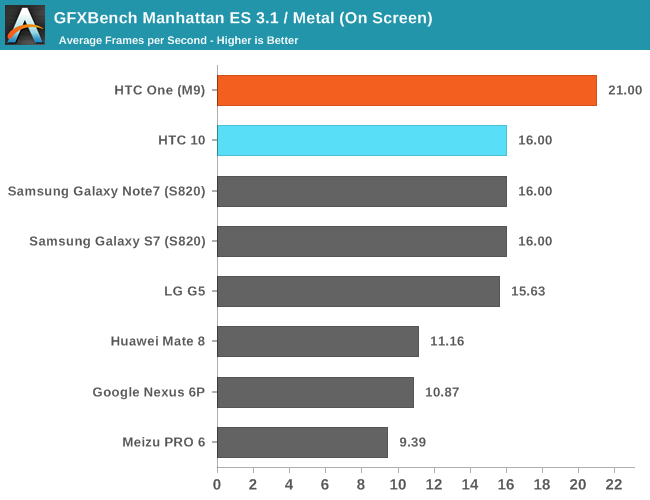


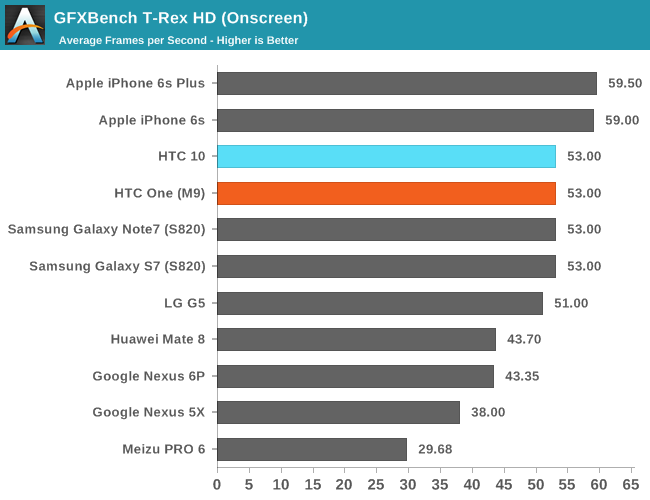
In the on-screen tests we can see the impact that the extra resolution has on GPU performance. Despite Adreno 530 providing a significant performance uplift the HTC 10 can actually give less GPU performance at native resolution depending upon the workload. Car Chase is fairly tesselation-intensive and uses ES 3.1, while ES 2 and ES 3 tests like Manhattan and T-Rex see parity between the two.
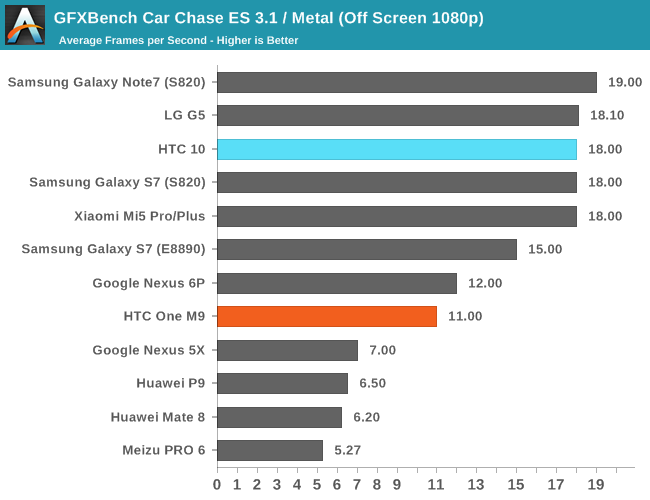
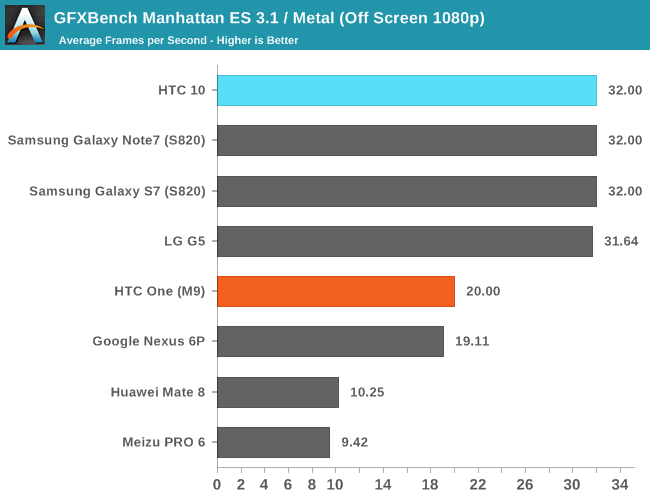
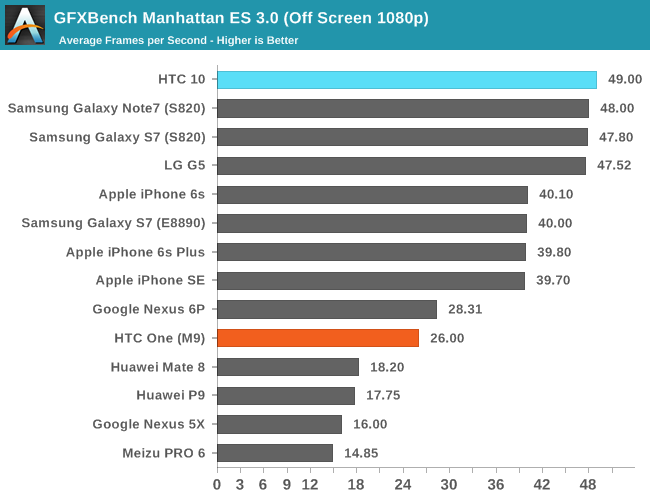
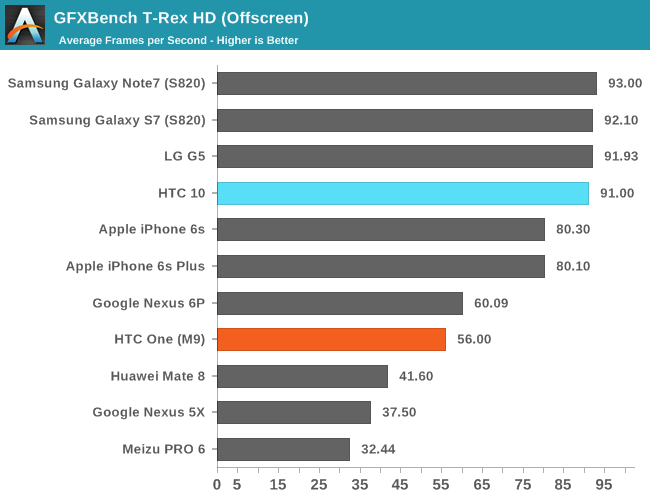
In 1080p off-screen rendering we see performance similar to applications that would render at non-native resolutions. Here the HTC 10 significantly outperforms the One M9 across the board and is in line with other Snapdragon 820 devices which is probably not a surprise.
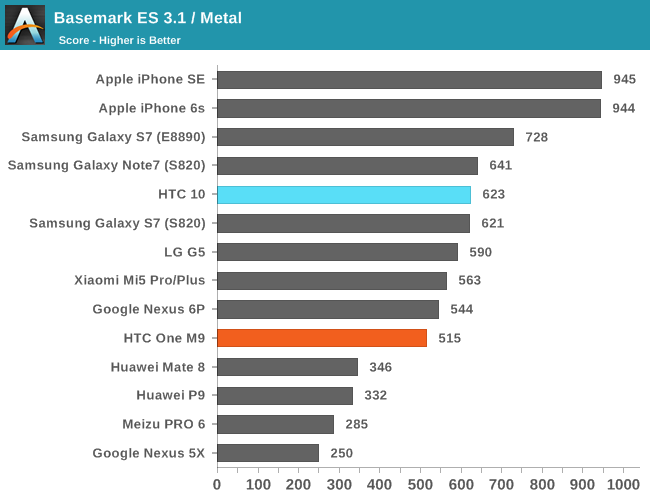
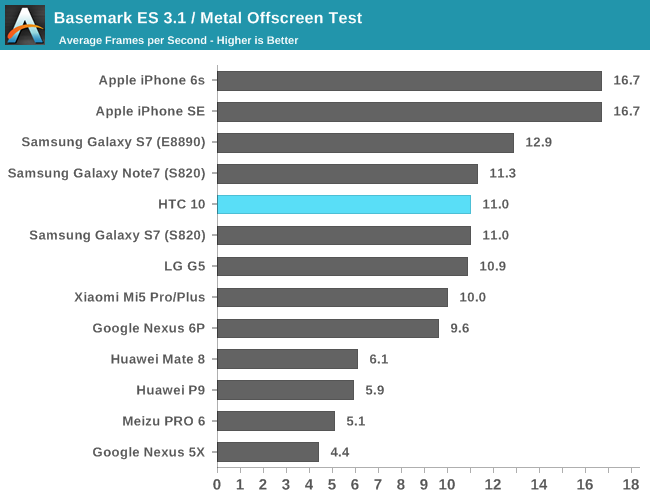
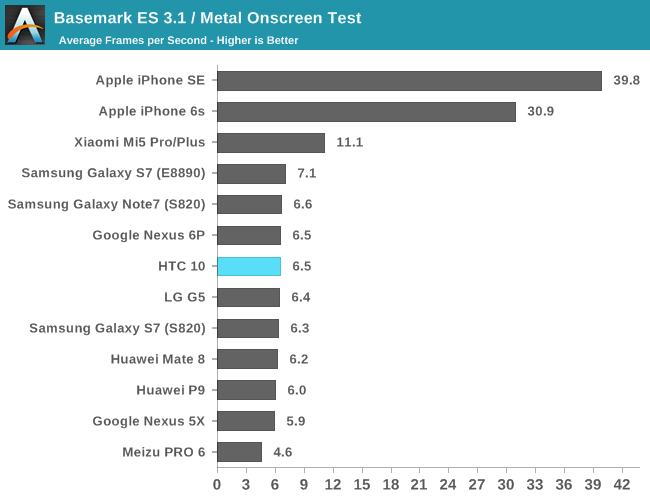
Performance here shows an uplift over the One M9, but this is primarily because the scores are based upon the off-screen results where resolution is equalized.
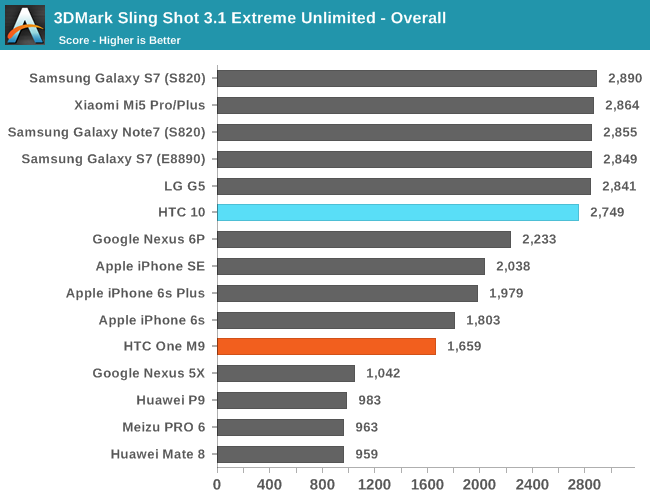
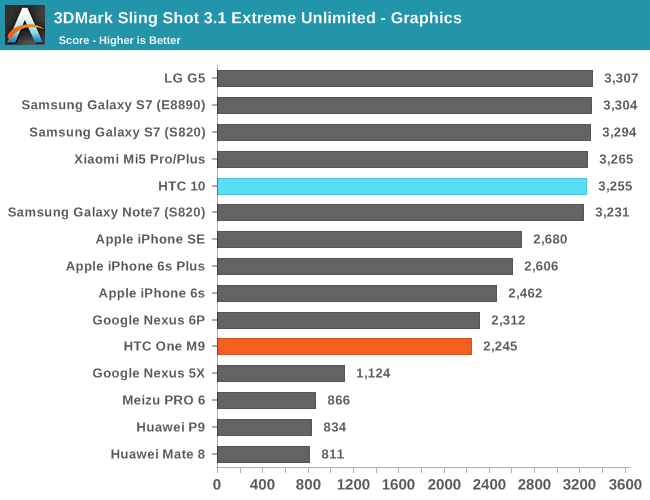
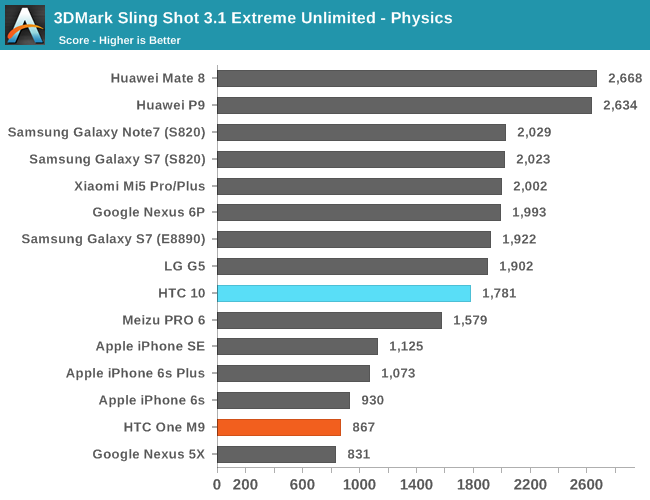
As 3DMark relies on off-screen rendering again we can see the benefit of Adreno 530 over Adreno 430 but this can only be achieved if you use the game optimization settings in the Boost+ application. Overall this isn't particularly notable outside of simple verification that nothing is seriously wrong with the software and hardware on the HTC 10.
NAND Performance
Storage performance, while decidedly difficult to test well in the mobile space and generally not all that well covered remains a fairly critical component of overall system performance. It’s definitely possible to hide memory performance issues with caching, but if you’ve ever taken a course on these things you can see that there is an upper bound to performance when it comes to caching. As a result, being able to improve performance at each step of the memory mountain is critical to having low latency and high throughput for data in the system. In order to test storage performance on mobile devices, we continue to rely on AndroBench 4 for Android devices. In order to properly test storage performance in a somewhat realistic manner we elect to test with only one I/O thread and a 100 MB test set with 4KB and 256KB block sizes for random and sequential rather than the strange settings of 8 threads and a 32MB sequential test which seems to be geared towards generating the largest numbers humanly possible rather than any meaningful throughput figure.
In the case of the HTC 10 it’s probably not a surprise at this point but it uses iNAND 7232 from SanDisk, seemingly as a single source supplier. This uses the SLC/TLC hybrid configuration seen in devices like the LG V10, iPhone 6, 6s, and 7 as well. The SLC storage is on the order of a few hundred megabytes, so sequential writes that exceed this size will see a drop-off in performance.
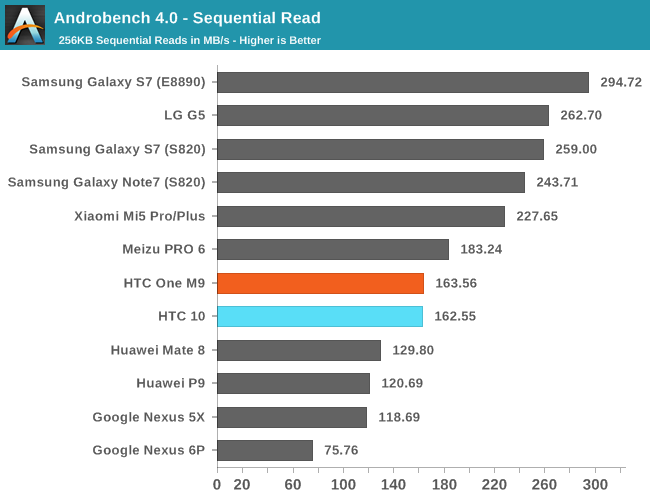
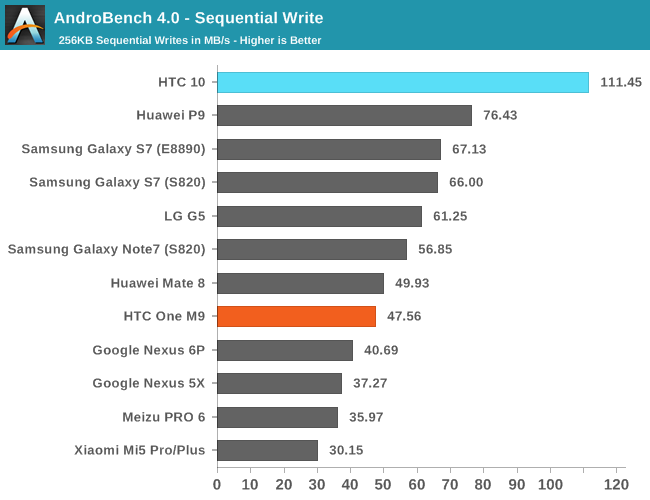
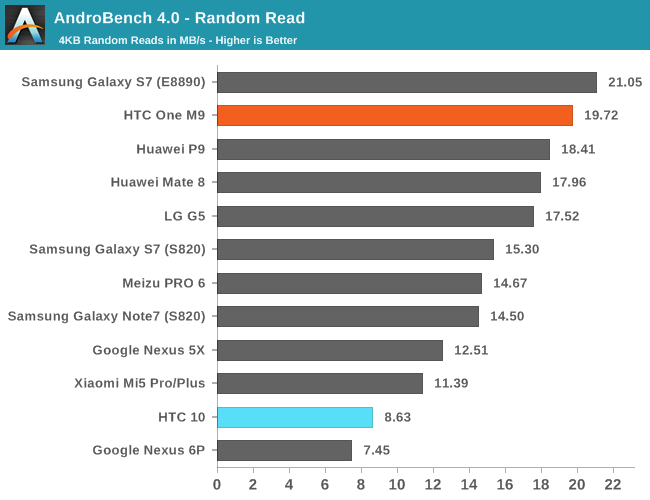
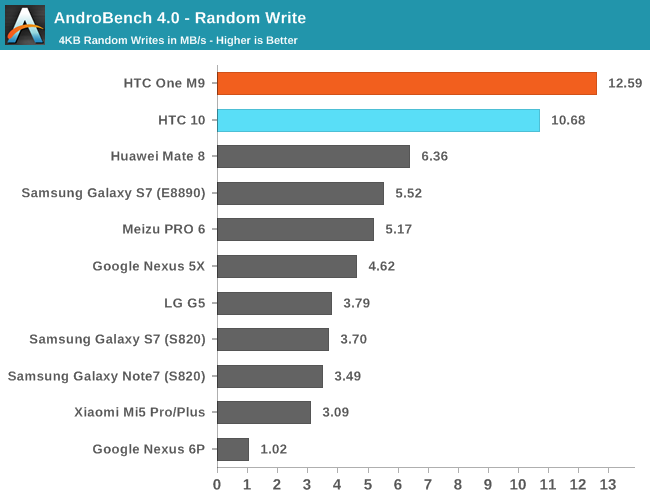
These results are probably not a surprise if you’ve been following our recent coverage but it’s still worth noting how the use of eMMC 5.1 is not guaranteed to be a huge impediment, although I would say this is probably the last generation where it’s acceptable to ship eMMC in a flagship device as the eMMC spec doesn’t seem to be progressing much further and UFS/NVMe solutions really seem to be the way forward as far as the industry is concerned. The HTC 10 is not really that far off from the UFS solutions we’ve seen in phones like the Galaxy S7 and from the Discomark results you can see that the eMMC 5.1 solution used here isn’t really causing a huge difference in performance, but I suspect anything that can actually take advantage of UFS’ more sophisticated controller will really start to highlight the weakness of eMMC and SDIO. At this point the industry already has UFS as a fairly widespread standard so HTC could take this route for a future flagship or NVMe storage depending upon their logistics. It's really important to emphasize here how UFS and NVMe are not necessarily better one way or another, as these things only matter when the storage or storage controller isn't the bottleneck.










183 Comments
View All Comments
Awful - Monday, September 19, 2016 - link
This review is interesting insofar as it gives insight into what we might see coming from HTC in the new Pixel (Nexus) phones on Oct 4...so in some ways the timing isn't so bad. I gave up on 3rd party phones after the nexus 5...Impulses - Thursday, September 22, 2016 - link
Ditto.Fidelator - Monday, September 19, 2016 - link
Fantastic review, the HTC 10 is really as good as I hoped it to be, which is basically the top of the hill, I'm sure a lot of readers would appreciate a new Audio quality section on these reviews, of course, keeping some subjective comments on the speaker quality and listening experience, it's an important piece of what makes a device great.Definitely considering this as my next device
randomguy128 - Monday, September 19, 2016 - link
What do you mean by featured review. Did HTC have to pay you guys to finally do this reviewvision33r - Monday, September 19, 2016 - link
Good phone 8 months ago. HTC failed to deliver a bigger size 10, fewer people in Asia buys phones smaller than 5.5" these days. Every Android OEM in China starts at 5.5" and work their way up to 6"Anakha - Monday, September 19, 2016 - link
Wow... Anandtech beat HTC South Africa. I had a bet with a friend on which would come first, the review on Anandtech or the release of the HTC 10 in South Africa. Sadly, we are still waiting for the 10 in South Africa and it got to the point where I said stuff it and upgraded my contract to the Huawei P9 Plus. I was really looking forward to the 10 but I just could not hold onto the M8 for any longer and needed something better. Hopefully next year HTC can launch on time...Vagabondjonez - Tuesday, September 20, 2016 - link
awesome story manzeeBomb - Monday, September 19, 2016 - link
That distillation starts at the name it seems as rather than the One M10 as you might expect given that the naming scheme for the past few generations has meant that its predecessors are called the One M8 and One M9.Wut
asfletch - Tuesday, September 20, 2016 - link
I would just like to echo comments praising the review and disagreeing with the 'too late' sentiment. The 10 launched here in Australia at ~US$830 and is still around US$750 at major retailers. I wasn't at all sure it was worth so much, so I ended up going with a NOS Note 4 instead for half the price.Now I am armed with the confirmation I need that it's the phone for me (and knowledge that I want a Sharp rather than Tianma display version), I am happy to wait until it drops closer to $400 and my Samsung wears out. I like reading on 5.7" but I'll be happy to go back to 5.2 for my next phone for easier one-handed use.
PS if LG made a V20 mini I'd be all over it (no, the G5 is not that phone).
jtang97 - Tuesday, September 20, 2016 - link
Only a small paragraph about the audio quality of the HTC 10? It always amazes me that a lot of sites when reviewing mobile PHONES do not talk about the audio quality. Sure, it might not be used for conversing with others so much anymore but it's still important.Also, I don't know what version you are using, but when I change the volume, the audio slider disappears after a few seconds. It has NEVER remained on the screen like you claim it does. Tapping on the screen after you moved the slider only makes the slider disappear faster.